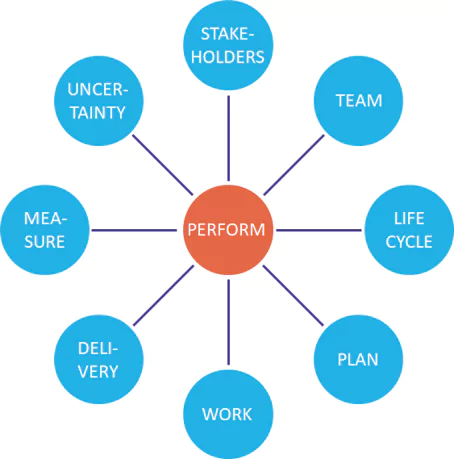Everyone can cook, but not everyone is a cook. Everyone can sing, but not everyone is a singer. Everyone can dance, but not everyone is a dancer. Our profession is no different: everyone can track teamwork, but this does not make them project managers. If we need to know if a cook is a good professional, we do not need evidence to ensure that certain procedures are followed. We check the value result: we taste his or her food.
Then project management will be considered a real profession by anyone – managers, team members, colleagues, friends, family, universities, companies, NGOs, governments, etc. Anybody can recognize a good or a bad singer, cook, etc. Analogously, anybody should be able to tell, objectively, if a project manager is a good or a bad professional. Sources of evidence should be understandable by anyone, not just PMP® certificates, or similar.
« Non-experts should know whether a project manager is a good or bad professional. »
Organizations leading the project economy don’t want bureaucracy related to documentation, workflows, or meetings. Project professionals should master their power skills. Today, projects succeed only if people collaborate on project management. Quoting the famous Agile Manifesto:
« Individuals and interactions over processes and tools. »
In August 2021, PMI released the 7th edition of the PMBOK, which represented a significant shift from processes to performance domains, that is, moving from outputs (documents) to outcomes (value results).
The 8 project management performance domains, easy to understand by stakeholders, makes everybody can tell if the project is being well managed:

- Stakeholder Performance Domain: Are the stakeholders properly engaged? Are change requests, comments, feedback responded on time? Is project communication properly managed?
- Team Performance Domain: Is there a synergetic cohesive project team? Are team members aware of their role inside the global context? Can they submit anonymous comments? Do they waste much time on nonproductive activities, such as submitting time and expense sheets? Is the PM performing as an effective leader?
- Development Approach and Life Cycle Performance Domain: Do we know the current phase the project is in? Is this project being managed on the right predictive/hybrid/agile approach? If agile, is the scope being progressively elaborated on cyclic iterations?
- Planning Performance Domain: Is this project properly founded? Has it been approved by a top manager? Has the scope been broken down into manageable work packages? Is everyone clear on the main milestones? The main dependencies? Can the project manager tell what is going to happen today, this week, this month, etc.? Who is going to do what, and by when? How much will the project cost? When is the project due to finish?
- Project Work Performance Domain: Do we have a project status report? Can we review how the project was doing one month ago? Are changes controlled? Are the project work data and lessons learned continuously recorded?
- Delivery Performance Domain: Are deliverables submitted with the proper cadence? Are they validated?
- Measurement Performance Domain: Are time and cost deviation regularly measured? Are time and cost forecasts reasonably accurate? Are corrective/preventive actions taken timely? Are time sheets and expenses controlled?
- Uncertainty Performance Domain: Are serious problems anticipated before it is too late? Are there too many surprises? Are there too many crises and improvisation? Have risk responses been effective?
Project Outcomes proved with PMPeople

PMPeople is the tool for the Project Economy. All types of organizations manage projects, programs, and portfolios to turn ideas into reality. Organizations are getting “projectified” and need project professionals to ensure predictability, accountability, and final success of each project.
With PMPeople, stakeholders can check the project management outcomes on the 8 performance domains from the evidence of good or bad performance, at the level of each project work package:
- Stakeholders: “The project needs a productive working relationship with stakeholders throughout the life cycle. Stakeholders who are project beneficiaries should be supportive and satisfied; stakeholders who may oppose the project or its deliverables should not negatively impact project results”. With PMPeople, project professionals can update the stakeholder register with the engagement assessment information –unaware, resistant, neutral, supportive, leading–, process their changes, comments, feedback, etc. Project professionals can identify challenges associated with individual stakeholders by reviewing the project stakeholder register, the issue log, the comments log and the change log.
- Team: “The project team should be high performance, empowered, resilient and aligned with objectives. They should trust each other and keep ownership of deliverables and outcomes in a collaborative environment”. With PMPeople, project professionals can explain the expected results to team members, read their comments –which can be anonymous– approve time sheets and expenses, etc. Team members can check their assignments, complete tasks, know who they work with, update the team charter, submit comments and retrospective information to the project manager, read feedback on them from managers and stakeholders, etc.
- Development Approach and Life Cycle: “The project should follow a lifecycle –predictive, adaptative, or hybrid – which is consistent with the development approach for the project deliverables. The series of phases of the project lifecycle should help governance and project termination if strategic criteria are no longer realizable”. With PMPeople, project professionals can set the management phase –initiation, planning, execution or closing– and the technical phase used inside the business unit. Project professionals can manage predictive, adaptive and hybrid projects, publishing periodic progress reports.
- Planning: “Project managers should visualize next week, next month, how to get the project done, etc. The planning model should be holistic, including the component needed to manage stakeholder expectations, and progressively elaborated as new information is discovered”. With PMPeople, project professionals can practice progressive elaboration of scope, schedule, cost, funding, resources, deliverables, requirements, tasks, etc.
- Project Work: “Status reports should demonstrate that project work is efficient and effective. Quality assurance should show that the processes are relevant and effective. The project communications should be effective to engage stakeholders. Procurement and material resources should be managed properly. Projects using a predictive approach should have an integrated change management procedure. Projects using an adaptive approach should have an updated product backlog. The project team should minimize rework and optimize velocity”. With PMPeople, Project professionals can update periodic follow ups, manage procurement items, communication, comments, changes, lessons learned, retrospectives, etc. Project professionals can control work in agile projects and outsourced projects.
- Delivery: “Project should demonstrate alignment to the organizational strategy and business. Project benefits should be realized in the time frame in which they were planned. Deliverables should be validated, and requirements should be met”. With PMPeople, project professionals can check the project charter and the business case, manage deliverables, requirements, etc. Project professionals can measure stakeholders’ satisfaction based on their comments, changes requested, and feedback provided.
- Measurement: “At each project review meetings measurements should indicate whether the project is performing as expected or if there are variances, in order to take timely and informed decisions and actions”. With PMPeople, managers can check performance against baselines at each review date. Some status report data can be shown to stakeholders. Reliable organizations can certify project status reports in blockchain.
- Uncertainty: “The project management team should be alert to anticipate any opportunity or threat which may have a positive or negative effect on a project’s objective or value delivery”. With PMPeople, project professionals can manage risks, contingency and management reserves. Project professionals can review the risk repository for similar projects in the past: “Yesterday’s problems are today’s risks”. Team members can comment anonymously on potential problems.
PMPeople is a technology for project professionals to collaborate using roles. Launched in April 2018 for PMOs and project professionals using 12 collaborative roles to work in teams professionally, in the cloud, collaborating on projects, programs and portfolios.
PMPeople goes beyond simply following workflows, chains of supervision, processes, or document templates: it promotes people interact as individuals. Project Managers can manage projects at many organizations using predictive and agile frameworks. Stakeholders can supervise many projects and give feedback with their mobile application. Team members can know their teammates and job descriptions, submit comments, timesheets, expenses, etc.
PMPeople is aimed to unify professional project management by these differential points:
- Designed by and for professional project managers, following professional project management standards.
- Online productivity –less meetings, less documents, less workflows– through distributed collaboration among 12 specialized roles: Organization Owner, 6 roles on demand management and 5 roles on supply management.
- Freemium product –unlimited time, unlimited users– usable via web and mobile application.
Start using PMPeople for free, for unlimited time and for any number of users. In premium organizations, only managers have a cost. Several roles –stakeholders, team members, sponsors, and resource managers– are always free. You can increase or decrease your premium seats according to the organization’s actual needs. Premium organizations have access to our online interactive support. Our servers are located in the EU. This software can also be hosted on customer premises.
Jose Barato
Related posts
Categories
- Business (16)
- Demand Management Roles (14)
- Frequently Asked Questions (7)
- Guide (26)
- People (23)
- Assignments (2)
- Feedback (2)
- Project Team (3)
- Tracking Time And Expenses (2)
- Process (9)
- Closing (2)
- Executing And Controlling (2)
- Planning (1)
- Project Management (67)
- Management Frameworks (18)
- Organization Owner (OO) (3)
- Project Economy (54)
- Tools (19)
- Supply Management Roles (5)
- Training (6)
- Uncategorized (1)





